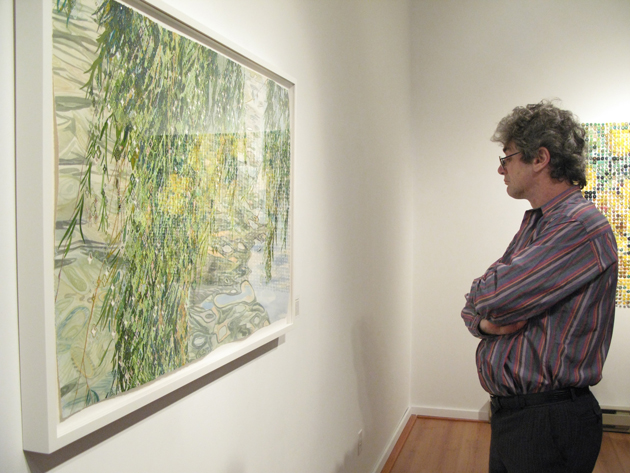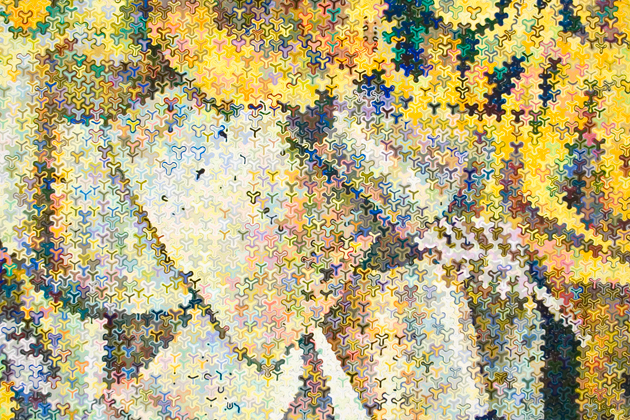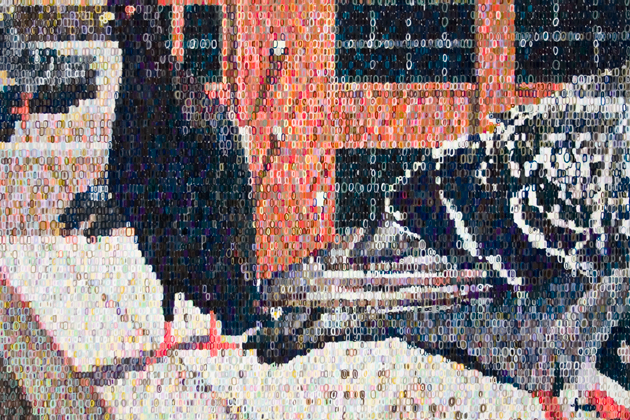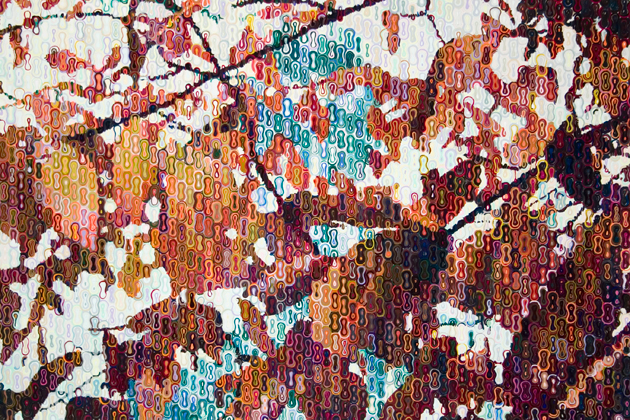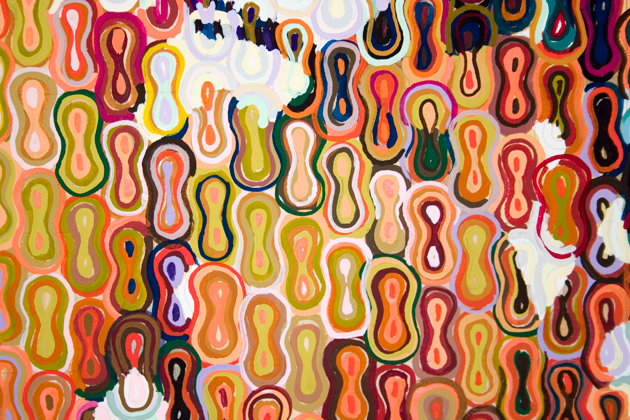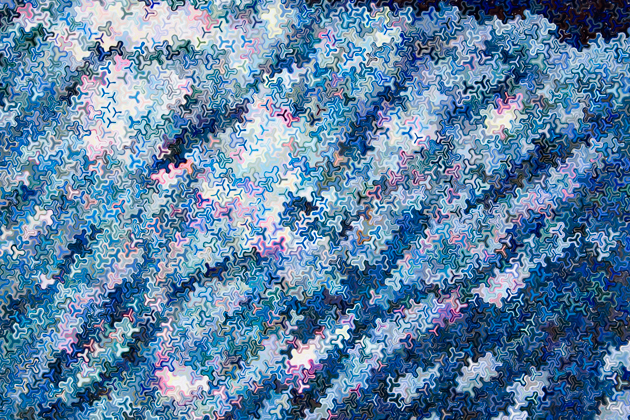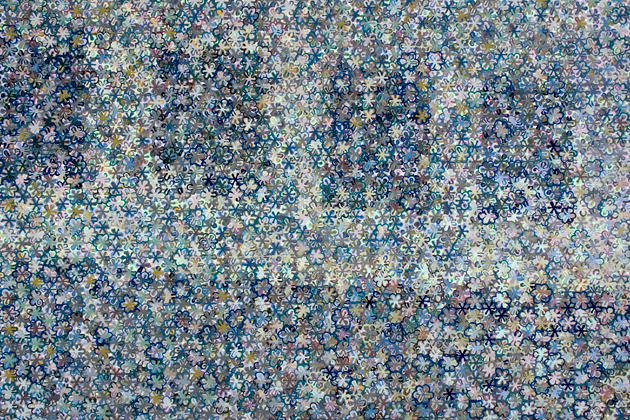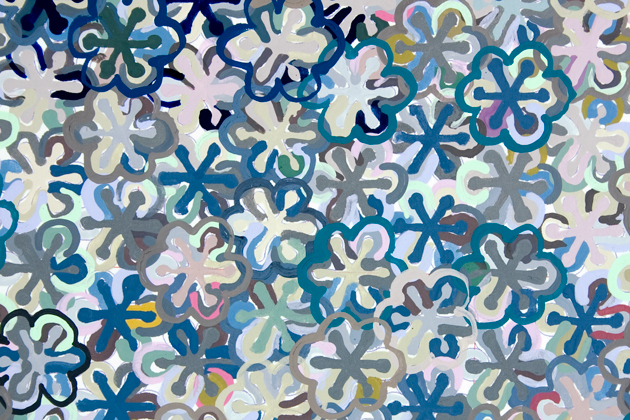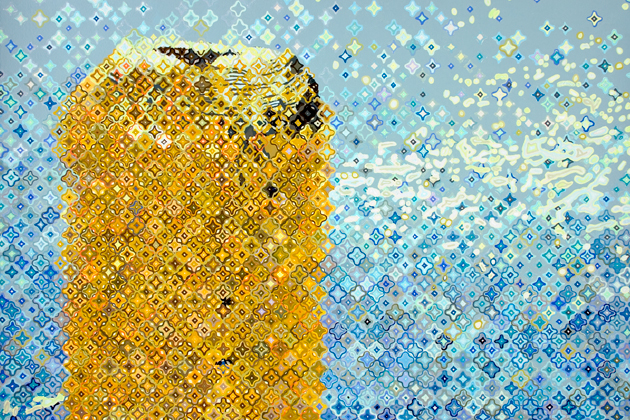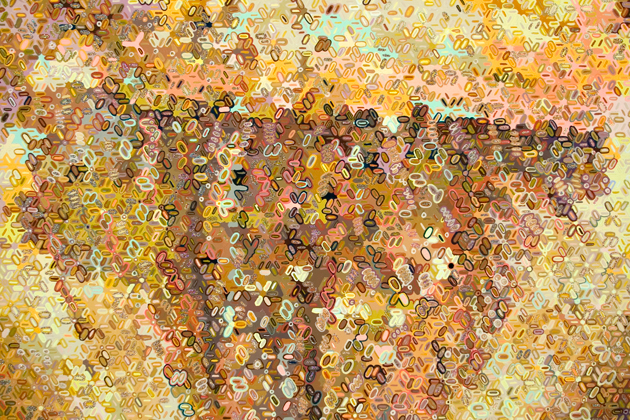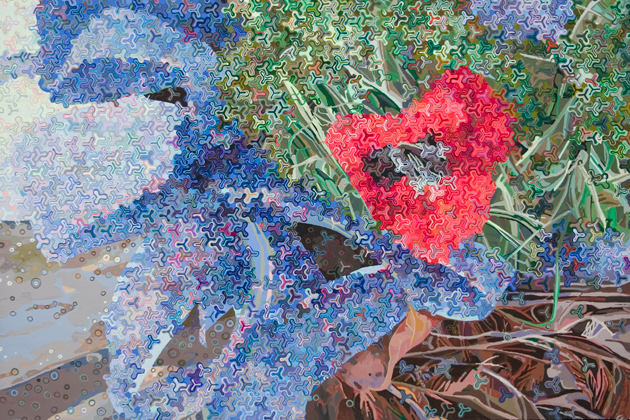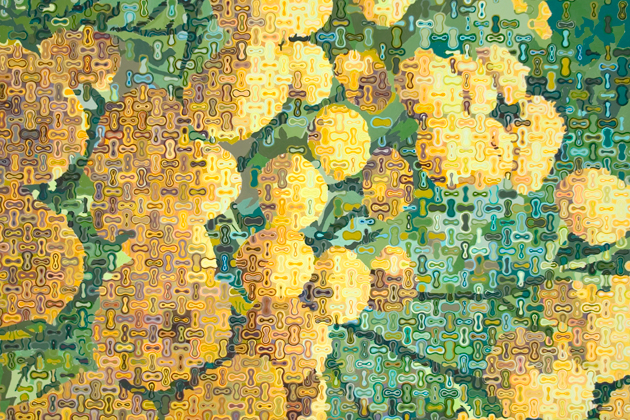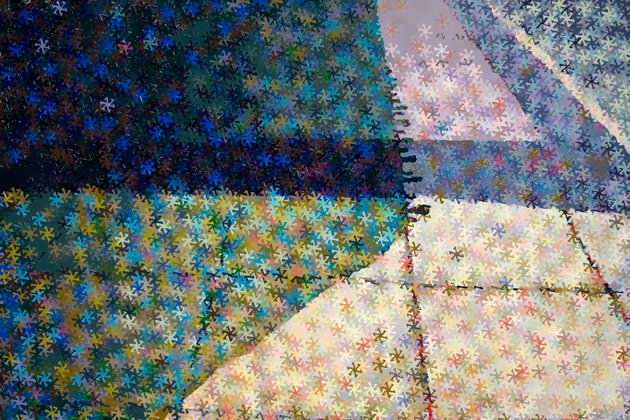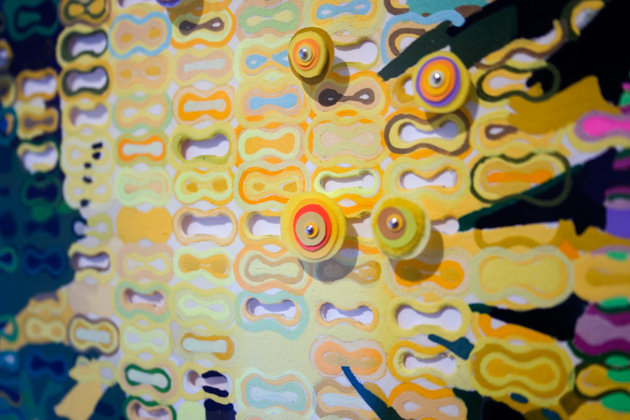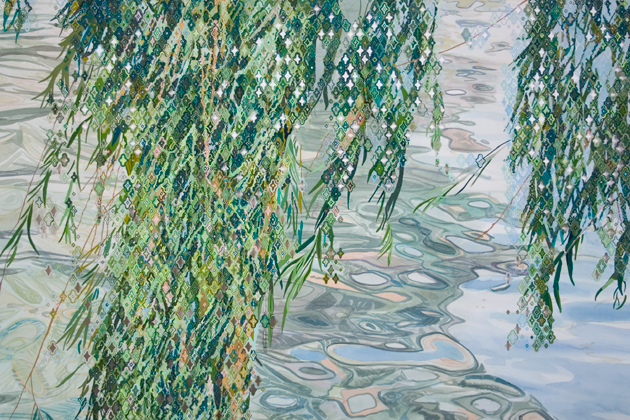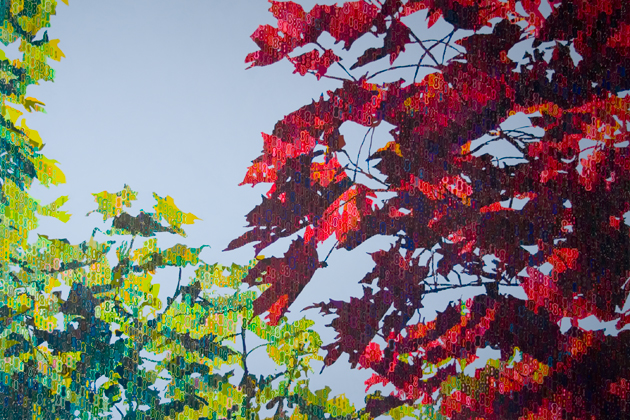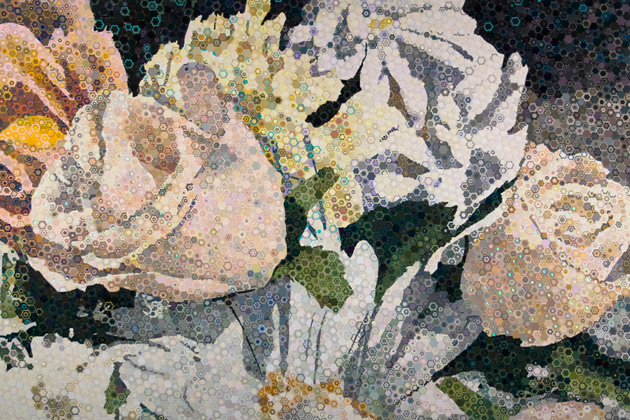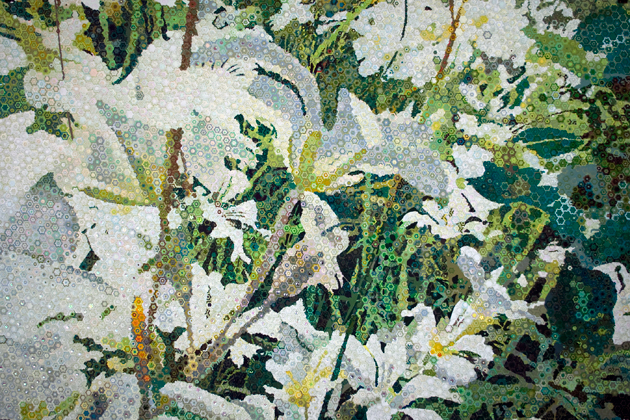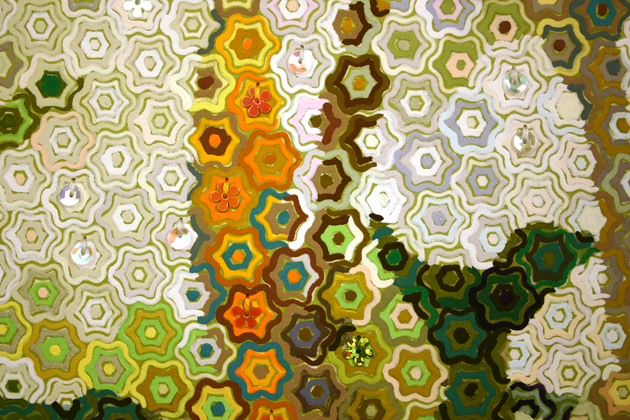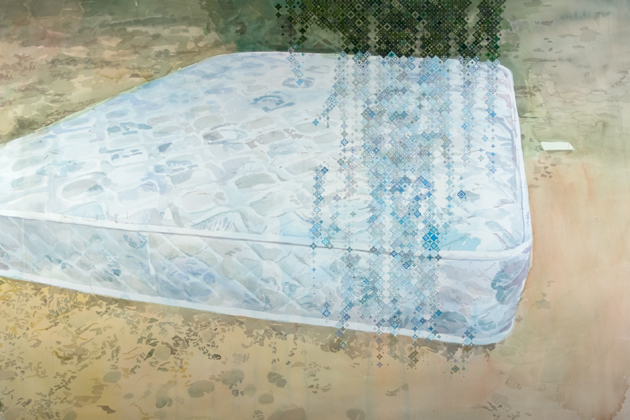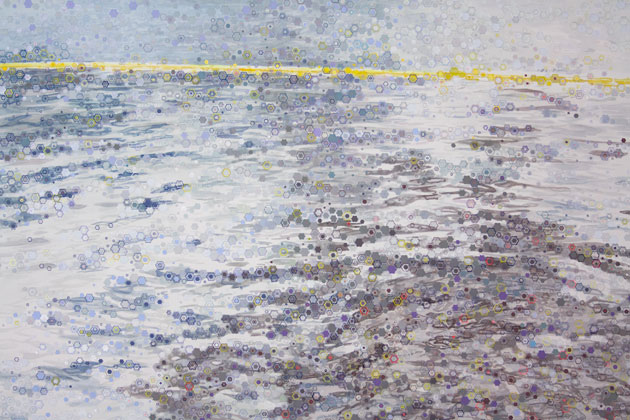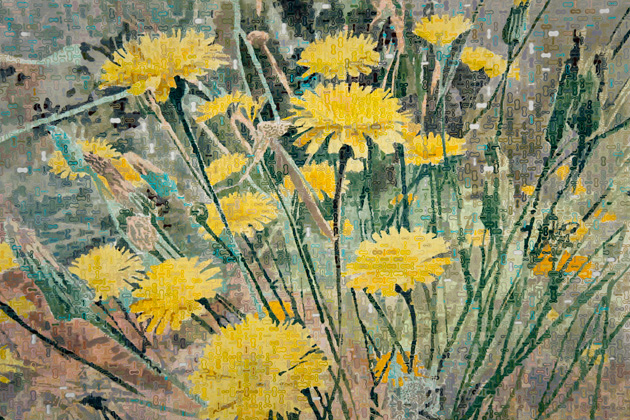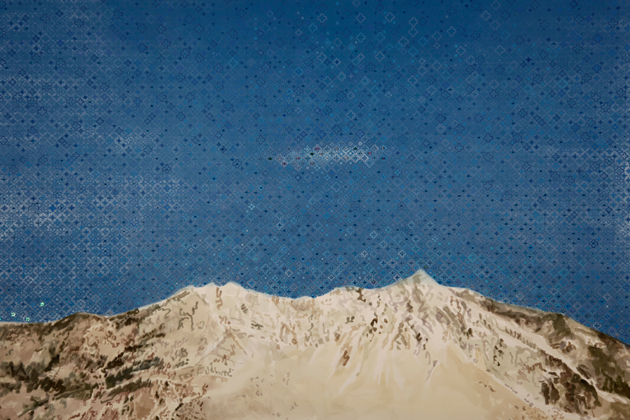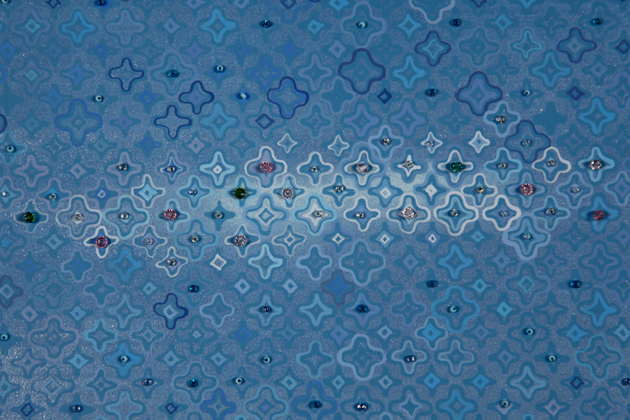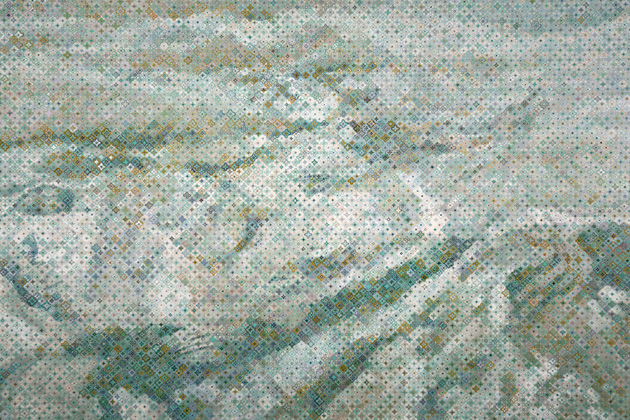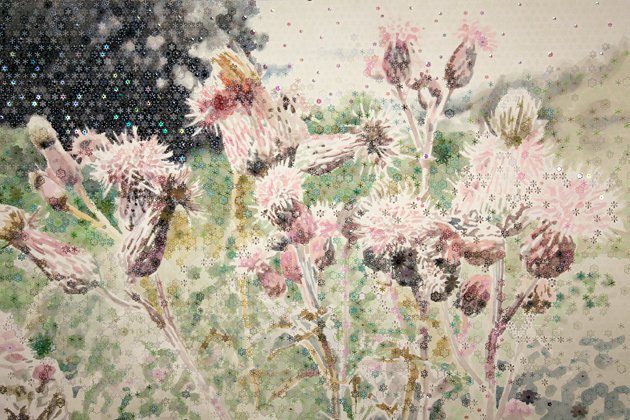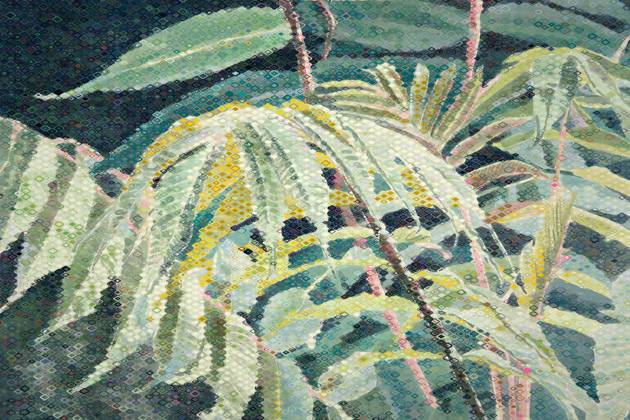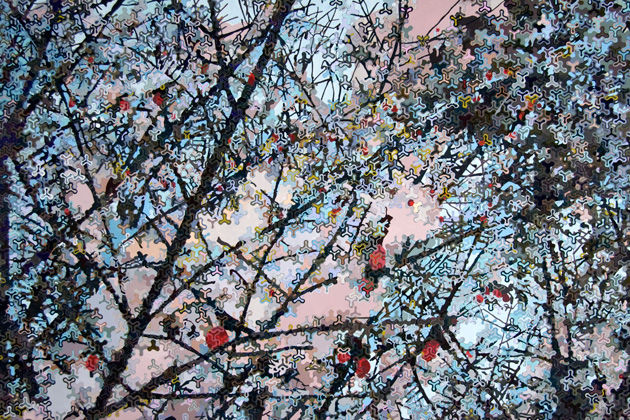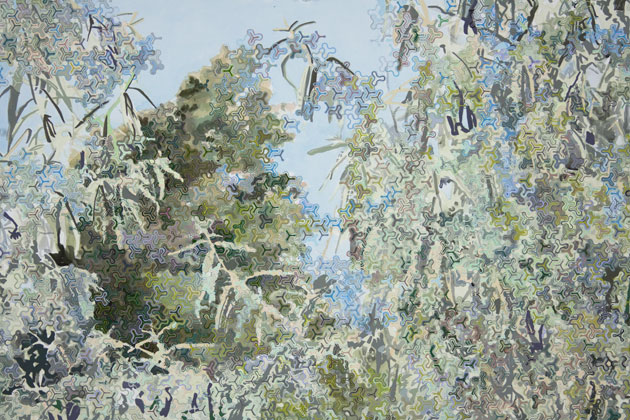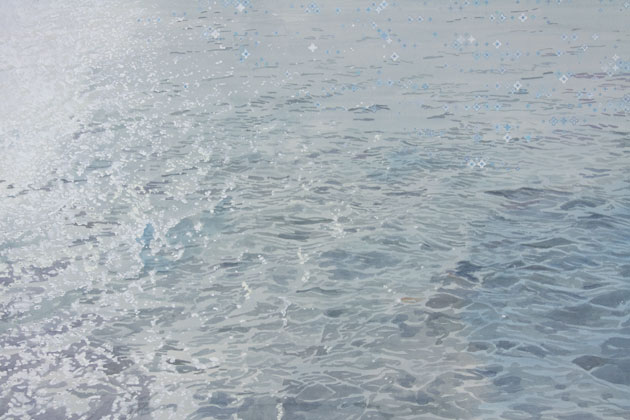100 DRAWINGS (2005-2011)
One Hundred Drawings is a series of works done in watercolour on paper with overlays of screenprint, gouache. Some have hand-sticthed sequins and beads. Each one depicts a site of disaster that have I have visited and re-photographed. Although the nature and magnitude of each event covered by my project varies considerably throughout the series, all the events have been pictured in the media, simultaneously marking them as historical and thus fostering ongoing attention. In opposition to the spectacle triggered by the media coverage of each event, I have focused on the elusive qualities of each site.
Exhibition View, Deluge Contemporary Art, 2008
Mine Disaster, Cherry, IL, November 13, 1909
(Drawing #1 from the 100 Drawings Project), 2005,
Gouache and pigment based ink on watercolor paper, 15 x 22 inches, private collection.
Sometime after noon on Saturday, November 13, 1909, a fire broke out in a coal mine located in the small town of Cherry, IL. The mine had an electrical lighting system but had been lit by kerosene torches due to a power outage. Sometime after lunch, six bales of hay were loaded into a coal car and lowered into the shaft for the mules. Disastrously, the hay came into contact with one of the kerosene torches and started a rapid blaze that resulted in the deaths of 259 men and boys. At the local cemetery you can find a monument to the victims erected by the United Mine Workers of America. This drawing depicts a bouquet of plastic flowers on one of the miner's graves located on this site.
Eastland Disaster, Chicago, IL, July 24, 1915
(Drawing #2 from the 100 Drawings Project), 2006
gouache and pencil on watercolor paper, 15 x 22 inches
private collection.
Early on the morning of Saturday, July 24, 1915, approximately twenty-five hundred employees from Chicago's Western Electric Company boarded the S.S. Eastland to attend a company picnic in Michigan City, Indiana. Due to new lifeboat regulations adopted after the sinking of the Titanic three years prior, the ship was extremely top heavy and began to list dangerously to the port side; eventually rolling over to rest near the south side of the Chicago River between Clark and LaSalle Streets. Many of the passengers were tipped into the water or trapped inside the passenger ship resulting in the loss of 845 lives. Today, a plaque located on the Clark Street Bridge commemorates the victims of the disaster. This drawing depicts the site of the disaster from this bridge. In the background is the Reid-Murdoch building which acted as a temporary morgue for the victims.
TWA flight 800 crash, East Moriches, Long Island, July 17, 1996
(Drawing #3 from the 100 Drawings Project), 2006,
gouache and pigment based ink on watercolor paper, 15 x 22 inches
private collection
On the evening of July 17, 1996 a TWA Boeing 747 exploded mid-air and plummeted into the Atlantic Ocean about eight miles off the coast of East Moriches, Long Island. Eyewitness accounts of the explosion induced a controversy that resulted in an investigation that was one of longest and most expensive in history, which comprised of the reconstruction of the 93-foot segment of the fuselage. Investigators considered the possibility of a terrorist attack and security screening was tightened at airports across the US. All 230 passengers died in the crash. This drawing depicts the location of the sky, seen through trees, just south of East Moriches where eyewitnesses saw the explosion.
TWA flight 800 crash, East Moriches, Long Island, July 17, 1996
(Drawing #3 from the 100 Drawings Project), 2006, gouache and pigment based ink on watercolor paper
15 x 22 inches, private collection
Earthquake, Seattle, WA, February 28, 2001
(Drawing #4 from the 100 Drawings Project), 2006
gouache and pigment based ink on watercolor paper, 15 x 22 inches
private collection.
On the morning of Wednesday, February 28, 2001, an earthquake measuring 6.8 occurred thirty miles southwest of Seattle, WA. Thirty people were trapped atop of Seattle's Space Needle and one woman died from a heart attack during the event, which was one of largest on record in the area. This drawing depicts the surface of the water just west of the Alaska Way Viaduct looking toward the epicenter of the quake.
MGM Hotel Fire, Las Vegas, NV, November 21, 1980
(Drawing #5 from the 100 Drawings Project), 2006
gouache, pigment based ink, and glitter on watercolor paper, 15 x 22 inches
private collection.
On the morning of November 21, 1980, a fire broke out in the MGM Grand Hotel and Casino in Las Vegas, NV. Faulty electrical wires powering a refrigeration unit were listed as the cause of the blaze. Once ignited, the fire spread rapidly and was fed by burning wallpaper and plastic, which caused toxic fumes that spread quickly through the hotel. Most of the victims were later found in stairwells locked behind doors that trapped each person. 87 people died as a result. This drawing depicts a fountain outside of the original site of the MGM, which was sold to Bally's Entertainment in 1985.
Triangle Shirtwaist Factory Fire, NY, NY, March 25, 1911
(Drawing #6 from the 100 Drawings Project), 2006
gouache and pigment based ink on watercolor paper, 15 x 22 inches
private collection
On the afternoon of March 25, 1911 a small fire broke out on the eighth floor of the Asch building located just east of Washington Square in New York City. At the time of the fire, the building filled with flammable textiles, was lit by open gas lighting and filled with smoking employees. The fire spread quickly. The employees on the ninth floor were not notified in time to escape from the flames that crept up the stairway of the one unlocked exit on that floor. In order to escape the engulfing fire many broke the windows and jumped to their deaths.150 people died as a result of the fire. The building survived and was later refurbished. It is now known as the Brown Building of Science at New York University. This drawing depicts the building in the reflection of a window across the street.
Triangle Shirtwaist Factory Fire, NY, NY, March 25, 1911
(Drawing #6 from the 100 Drawings Project), 2006,
gouache and pigment based ink on watercolor paper, 15 x 22 inches
private collection
Railway Wreck, Bayonne, NJ, September 15, 1958
(Drawing #7 from the 100 Drawings Project), 2006
gouache and pigment based ink on watercolor paper, 15 x 22 inches
private collection
On September 15, 1958, a commuter train ran through 3 lights as it neared Bayonne New Jersey. This tripped an automatic derailing device that sent the train plummeting into Newark Bay at Elizaport. 48 people died as the 3 of the coaches sank. This drawing depicts the water of Newark Bay as seen from the waterfront of Bayonne, NJ in the direction of the accident.
Hilton Hotel Fire, Las Vegas, NV, February 11, 1981
(Drawing #8 from the 100 Drawings Project), 2006,
gouache, pigment based ink, and glitter on watercolor paper, 15 x 22 inches
private collection.
On the night of February 11, 1981, a fire broke out at the Hilton Hotel in Las Vegas. Due to the fact that the event occurred only 90 days after the MGM fire, firefighters applied knowledge learned at the earlier disaster. 8 people died in the fire. This drawing depicts a chandelier located on the ground floor of the hotel.
Hope Slide, Hope-Princeton Highway, BC, January 9, 1965
(Drawing #9 from the 100 Drawings Project), 2007,
gouache and pigment based ink on watercolor paper, 15 x 22 inches
private collection
Early on the morning of Saturday, January 9, 1965, an enormous landslide descended across the Hope-Princeton Highway, a few miles south east of Hope, BC. The slide buried four people that were waiting for road crews to clear a stretch of highway previously covered by a small avalanche. Nearly 300 feet in depth and two miles in width, the slide buried its victims under a torrent of pulverized rock, mud and debris. Two memorials for the victims of the slide stand on the location of the site. This drawing depicts a wreath commemorating those that died there.
Second Narrows Bridge Collapse, Vancouver, BC, June 17, 1958
(Drawing #10 from the 100 Drawings Project), 2007
gouache and pigment based ink on watercolor paper, 15 x 22 inches
private collection
On June 17, 1958, construction on the Second Narrows Bridge came to a halt when a large portion of its span collapsed into the inlet. Strapped to the bridge with harnesses, eighteen workers lost their lives. My grandfather was collecting crab fishing in the inlet at the time and helped save some of the men that fell into the water. In the 1990's, the bridge was re-named Ironworkers Memorial Second Narrows Crossing as a tribute to the workers who lost their life during its collapse while it was being built. On both ends of the bridge are plaques commemorating the workers who died. This drawing depicts some small flowers located at the north end of the bridge.
Iroquois Theater Fire, Chicago, Il, December 30, 1903
(Drawing #11 from the 100 Drawings Project), 2007
gouache and pigment based ink on watercolor paper, 15 x 22 inches
Just after 3 pm on December 30, 1903, a light ignited a curtain on the stage of the Iroquois Theater during the production of a popular musical. When the protective asbestos curtain failed to drop completely, the actors and dancers exited out through the back door. The resulting draft ignited a fireball that quickly tore through the theater. Of the 1,900 people that were in attendance at the time of the blaze, 602 people died. After the fire it was discovered that firefighters were bribed with free tickets to overlook code violations. This drawing depicts the sidewalk in front of the Oriental Theater, which now stands on the site.
Nanaimo Mine Explosion, Nanaimo, BC, May 3, 1887
(Drawing #12 from the 100 Drawings Project), 2007
gouache, pigment based ink, and glitter on watercolor paper, 15 x 22 inches
private collection
Shortly before 6 pm on May 3, 1887, two explosions rocked the No. 1 Esplanade Mine, located just north of downtown Nanaimo, BC. The resulting fire and the carbon monoxide it produced resulted in the deaths of 147 miners and one rescuer. Near the entrance to the site is a memorial plaque listing the names of the miners that died in the accident. Of the dead listed are 53 Chinese immigrant workers known to the employers only by the numbers that were assigned to them. This drawing depicts a tree located near this memorial plaque.
Point Ellice Bridge Collapse, Victoria
BC, May 26, 1896
(Drawing #13 from the 100 Drawings Project), 2007
gouache, pigment based ink, and glitter on watercolor paper, 28 x 42 inches
Shortly after 2pm on May 26, 1896 during the height of the annual Victoria Day celebrations, an electric streetcar plunged from the iron-trussed Point Ellice Bridge into the cold waters of the Gorge Waterway. Loaded with 140 passengers, the streetcar was far heavier than the bridge was designed to handle and was pierced by crashing timbers and ironwork as it descended into the water. Fifty-five people drowned as a result.This drawing depicts a cloud floating over the site of the accident.
Point Ellice Bridge Collapse
Victoria, BC, May 26, 1896
(Drawing #13 from the 100 Drawings Project), 2007
gouache, pigment based ink, and glitter on watercolor paper, 28 x 42 inches
Murder of Eight Student Nurses, Chicago, IL, July 15, 1966
(Drawing #14 from the 100 Drawings Project), 2007
gouache, pigment based ink, cut paper, and pins on watercolor paper, 28 x 42 inches
private collection
On July 14, 1966 Richard Speck broke into a townhouse in South Chicago. Inside he found eight student nurses whom he took hostage. During the course of the night the women were repeatedly raped and beaten before he stabbed them to death on the morning of the 15th. One female, who was hiding under the bed during the attack, made it out alive. This drawing depicts a patch of grass just outside of the townhouse where the murders occurred.
Murder of Eight Student Nurses, Chicago, IL, July 15, 1966, (Drawing #14 from the 100 Drawings Project), 2007, gouache, pigment based ink, cut paper, and pins on watercolor paper, 28 x 42 inches, private collection
Noronic Disaster, Toronto, Ontario, September 17, 1949
(Drawing #15 from the 100 Drawings Project), 2008
Watercolor, gouache, pigment based ink, beads, wire, and cut paper on Arches CP 156 lb. watercolor paper, 28 x 42 inches
private collection
On the morning of September 17, 1949, a small fire was discovered in a locked linen closet aboard the passenger ship known as the S.S. Noronic. Once unlocked in an attempt to fight the flames with a single fire extinguisher, the fire raged out of control. It only took ten minutes for the fire spread rapidly throughout the interior of the ship because the woods in the ship were regularly treated with a lemon oil that was highly flammable. During the incident most passengers were sleeping and roused to a choking black smoke and packed corridors. Several of them escaped by jumping into the frigid waters of the Toronto Harbor. Most of the bodies were burned beyond recognition making identifying them difficult. This piece documents a weeping willow tree reflected in the water on the pier where the accident occurred. Nearby there is a plaque commemorating those who perished.
Harbour Explosion, Halifax, NS, December 6, 1917
(Drawing #16 from the 100 Drawings Project), 2008
Watercolor, gouache, and pigment based ink on Arches CP 156 lb. watercolor paper, 28 x 42 inches
private collection
At 9:04 on the morning of December 6, 1917, the Mont-Blanc, a French munitions ship inbound to Halifax, NS for a brief stop before heading off to the war in Europe collided with the outbound Imo, a Belgian reef ship. Due to the fact that the Mont-Blanc was carrying a load of gun cotton, TNT, and picric acid, the impact caused the ship to catch fire and blow up. The explosion had a devastating effect. It leveled much of northern Halifax and Dartmouth and caused 1,963 people to perish. Evidence of the disaster can still be found in Halifax including a broken window pane and a piece of wreckage that was driven into the wall from the blast. This drawing documents the area of sky, located between two maple trees, just above the site where the explosion took place.
Train Derailment, Mississauga, Ontario, November 10, 1979
(#17 from the 100 Drawings Project), 2008
Watercolor, gouache and watercolor pencil on Fabriano SP 140 lb. watercolor paper, 18 x 27 inches
At 11:53 pm on November 10, 1979, a train carrying styrene, toluene, propane, caustic soda, and chlorine derailed when passing through Mississauga, Ontario. An inadequately lubricated wheel bearing was the cause of the accident causing friction that ignited sparks and eventually got so hot that one pair of wheels fell off. The accident resulted in a huge explosion and fireball that reached 1,500 meters into the sky. A cloud of chlorine gas resulting from the accident caused the largest evacuation in peacetime history until Hurricane Katrina at more than 200,000 people. With the exception firefighters, who were exposed to the noxious fumes until the crisis was under control, there were no deaths from the accident. This work documents some flowering thistles at the site where the accident occurred.
Fairview Cemetery, April 15, 1912
(#18 from the 100 Drawings Project), 2008
Gouache, pigment based ink, and sequins on watercolor paper, 28 x 42 inches
This piece documents the flowers on gravesite holding Titanic victim 221, located in Fairview Cemetery in Halifax, NS. Three Canadian ships were involved in recovering the victims of the disaster. Of the 328 bodies recovered, Fairview cemetery holds the largest number of victims from this disaster. They are buried under unmarked graves identified only by numbers that refer to the order in which they were found.
S.S. Atlantic Wreck, Lower Prospect, Halifax, NS, April 1, 1873
(#19 from the 100 Drawings Project), 2008
Gouache,pigment based ink, and sequins on watercolor paper, 28 x 42 inches.
On the dark morning hours of April 1, 1873, the S.S. Atlantic struck an underwater rock called Marr’s Head as it attempted to make port in Halifax Harbour to replenish supplies. Due to heavy seas and limited visibility, the ship was 20 km off course. Although lifeboats were lowered into the water by the crew they floated out of reach in the rough seas. All women and children on board perished except for one boy. My drawing documents the flowers near a large single grave that holds 277 of the 562 victims of the wreck.
S.S. Atlantic Wreck, Lower Prospect, Halifax, NS, April 1, 1873
(#19 from the 100 Drawings Project), 2008
Gouache,pigment based ink, and sequins on watercolor paper, 28 x 42 inches
Sayward Fire, Campbell River, BC, Canada, July 5, 1938,
(#20 from the 100 Drawings Project), 2008
Watercolor, gouache, pigment based ink, and sequins on watercolor paper, 36 x 54 inches, private collection.
On July 5, 1938 sparks from a yarding engine operating just north of Campbell River on Vancouver Island started a fire in some felled trees. Fifteen thousand firefighters worked to control the blaze yet it raged on for 30 days, creating a black scar on the earth measuring 75,000 acres. A massive replanting effort during which almost 800,000 Douglas Fir trees were planted helped to regenerate the forest. Today the undulating topography of the Sayward Forest is home to a variety of wildlife including Black-tailed deer, Roosevelt elk, black bears, cougars and gray wolves, and is largely covered with Douglas Fir, Western hemlock, Cedar and Sitka spruce. My drawing documents a mattress left by the side of a lake where the fire burned.
Hurricane Gabrielle, Halifax, NS, September 10, 1989
(Drawing #21 from the 100 Drawings Project), 2011
Watercolor, gouache, screenprint on watercolor paper, 30 x 45 inches.
On September 10, 1989, a large hurricane hit the shores of Atlantic Canada and battered the coast of Nova Scotia with seven to ten meter swells. One man gathered to watch the large swells and was killed when a huge wave swept him into the ocean.
Tacoma Narrows Bridge Collapse, Tacoma, WA, November 7, 1940
(Drawing #22 from the 100 Drawings Project), 2009,
Watercolor, gouache and screenprint on cut watercolor paper, 30 x 45 inches.
On the morning of November 7, 1940, only four months after it opened to the public, the first Tacoma Narrows Bridge dramatically collapsed. Although no human lives were lost, a dog perished after it was abandoned in a car. The bridge, nicknamed “Galloping Gertie” for its wild undulating motion, attracted many visitors who would drive for miles to ride its swaying roadway. On windy days, cars were reported to vanish and reappear several times during a single crossing. This piece documents some dandelions growing near the site of the collapse.
Frank Slide, Crowsnest Pass, Frank, AB, April 29, 1903
(Drawing #23 from the 100 Drawings Project), 2009
Watercolor, gouache, screenprint, sequins and beads on watercolor paper, 30 x 45 inches.
During the early morning of April 29, 1903, a massive landslide dislodged the eastern limestone face of Turtle Mountain. The resulting rock pile spread over the valley floor, covering more than a mile of the Canadian Pacific Railway, a portion of the town of Frank, and most of the coal mine below. Nearly seventy people died in the event. This piece documents the eastern face of the mountain as it looks today.
Frank Slide, Crowsnest Pass, Frank, AB, April 29, 1903
(Drawing #23 from the 100 Drawings Project),
2009
Watercolor, gouache, screenprint, sequins and beads on watercolor paper, 30 x 45 inches
Hoboken Pier Fire, Hoboken, NJ, June 30, 1900
(Drawing #24 from the 100 Drawings Project), 2009
Watercolor, gouache, acrylic and screenprint on watercolor paper, 30 x 45 inches.
On June 30, 1900, a fire broke out on Pier 3 in Hoboken, NJ. Within fifteen minutes of the ignition, the blaze raced a quarter mile along the piers and continued to burn until several passenger liners and multiple small boats were on fire. Of the hundreds who died that day, many were trapped in ships whose portholes were too small to pass through. This piece documents the surface of the Hudson River where the event took place.
Ripple Rock Explosion, Discovery Passage, BC, April 5, 1958
(Drawing #25 from the 100 Drawings Project), 2010
Watercolor, gouache, screenprint, beads and sequins on cut watercolor paper, 28 x 42 inches
public collection: University of Pennsylvania.
Ripple Rock was a twin peaked underwater mountain located near the town of Campbell River, BC. Nearly twenty large vessels and about one hundred smaller ones fell victim to this treacherous rock before it was destroyed in 1958 by a planned explosion. The explosion created a column of debris that rose nearly 300 meters in height. It was considered a national historic event and was broadcast live on CBC Television. This piece documents some thistles growing on the side of the highway near the plaque that commemorates the event.
Ripple Rock Explosion, Discovery Passage, BC, April 5, 1958
(Drawing #25 from the 100 Drawings Project), 2010
Watercolor, gouache, screenprint, beads and sequins on cut watercolor paper, 28 x 42 inches
public collection: University of Pennsylvania.
Hurricane Hazel, Raymore Drive, Toronto, ON, October 15, 1954
(Drawing #26 from the 100 Drawings Project), 2010
Watercolor, gouache, and screenprint on watercolor paper, 28 x 42 inches.
On the morning of Thursday, October 14, 1954, Hurricane Hazel reached southern Ontario. By midnight of the following day, more than eight inches of rain had fallen and much of the metro area of Toronto was flooded. The Humber River rose twenty feet. Fourteen houses were swept into the river and thirty-two residents were killed. This piece documents some foliage on the side of the river in Raymore Park, which is dedicated to the memory of the disaster.
Great Fires, Goose Rocks Beach, Kennebunkport, ME, October 21, 1947
(Drawing #27 from the 100 Drawings Project), 2010
Watercolor, gouache and screenprint on watercolor paper, 18 x 27 inches.
Late in October 1947, southern Maine suffered tremendous losses due to forest fires. Goose Rocks Beach in Kennebunkport was hit particularly hard. Nearly one hundred early nineteenth century beachside cottages burned. To escape the flames, terrified residents and woodland animals ran onto the beach and hid under dampened blankets. This piece documents some trees located near the edge of the beach.
Go Train - Bus Collision, Toronto, ON, January 29, 1975
(Drawing #28 from the 100 Drawings Project), 2011
Watercolor, gouache, screenprint on watercolor paper, 18 x 27 inches.
On January 29th, 1975, a GO Transit Commuter train hit a stalled bus on crossing at in Scarborough. Nine people were killed in the accident.
The Sinking of the SS Valencia, off Vancouver Island, BC, January 22, 1906 (Drawing #30 from the 100 Drawings Project), 2011
Watercolor, gouache, screenprint, sequins and beads on watercolor paper, 28 x 42 inches
private collection.
I acknowledge the support of the Canada Council for the Arts, which last year invested $153 million to bring the arts to Canadians throughout the country.
Je remercie le Conseil des arts du Canada de son soutien. L’an dernier, le Conseil a investi 153 millions de dollars pour mettre de l’art dans la vie des Canadiennes et des Canadiens de tout le pays.

Bringing the arts to life
De l’art plein
